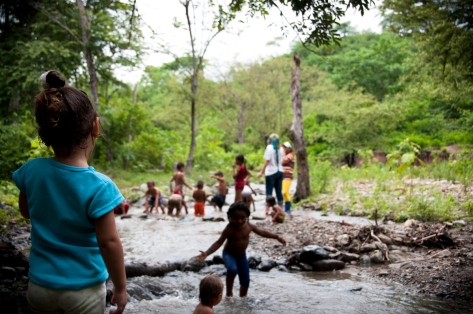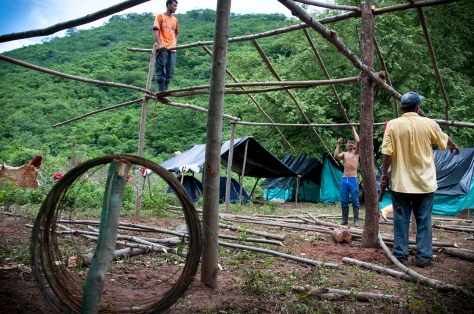It can be argued that political geography in particular began as the handmaiden of empire, war, and pillage. There are certainly many of us trying to use it now instead for social justice, equality, and peace - but I am outraged to report that some are still using it to steal people's land and resources. I think it's safe to call that the extreme opposite of solidarity. As part of a group effort to decolonize my discipline I am
re-posting the following article by my friend and colleague
Joe Bryan in its entirety:
The
Lawrence World-Journal
recently reported the Defense Department’s decision to fund the latest
Bowman Expedition led by the American Geographical Society and the
University of Kansas Geography Department
. Like the first – and controversial –
Bowman expedition to Mexico , this latest venture will be led by KU Geographers Jerome Dobson and Peter Herlihy and will target indigenous communities
.
Like previous
Bowman Expeditions ,
the expedition’s goal is to compile basic, “open-source,” information
about countries that can be used to inform U.S. policy makers and the
military
. This time, however, they won’t be focused on a single country
.
Instead they’ll be working throughout Central America, a region that
Herlihy and Dobson have elsewhere called “The U.S. Borderlands
.” What is this Expedition about? And why is the Defense Department funding academic research on indigenous peoples
?
As with the expedition to Mexico, Herlihy and Dobson are focused on land ownership
.
Echoing a growing list of military strategists, Herlihy and Dobson
contend that areas where property rights are not clearly established
and enforced by states provide ideal conditions for criminal activity
and violence that threaten regional security
.
Herlihy and Dobson propose to use maps made with indigenous
communities of their lands to clarify this problem, ostensibly with an
eye towards securing legal recognition of their property rights
. In their expedition to Mexico, Herlihy and Dobson turned over their findings to
Radiance Technologies , an Alabama-based military contractor specializing in “creative solutions for the modern warfighter
.” It’s not clear whether this new expedition will do the same, though the program funding it, the
Minerva Research Initiative , evaluates proposals according to their ability to address national security concerns
.
The rationale for these Expeditions has been parsed in
film ,
print , and by
academics (
myself included ),
revealing them to be little more than intelligence gathering efforts
carried out by civilian professors and their graduate students
. Zapotec communities visited by the previous expedition to Mexico have further denounced Herlihy’s and Dobson’s efforts as “
geopiracy ,” (and again
here )
that replay some of colonialism’s oldest tactics of extracting
information from communities for people (the U.S. Army) who live
elsewhere
. Zapotec communities in Oaxaca have also
accused Herlihy of failing to inform them of the U.S. Army’s role in funding the Expedition and process data collected by it
.
Military funding for the latest Bowman Expedition raises the question
of what the U.S. military wants to know about Central America
. Moreover, why is it funding research on indigenous peoples
?
It’s hard to imagine that the U.S. military has much interest in the
nuances that distinguish, say, Tawahka communities from Emberá ones
.
Nor does the military appear concerned with the chronic insecurity of
land rights, which continues to be one of the primary threats faced by
indigenous communities
. A far more likely answer lies with the military’s growing interest in collecting information about the
“cultural” or “human” terrain
that they can use as needed for a variety of purposes, from managing
risks posed by natural disasters to planning military interventions
.
Maps of the sort produced by the Bowman Expeditions are certainly
useful for this task compiling information about who lives where and
place names, to give two examples
. But maps can only describe the territory. What they cannot describe are the intricacies of the “
terrain ” such as the social networks through which access to land and resources are negotiated or the history of struggles over land
.
The U.S. military is more familiar with this terrain than one might think
.
Beginning with the “Banana Wars” of the early 20th Century, the U.S.
military has intervened more times in Central America that just about
any other region in the world
. Indeed the Marines’ first resource on counter-insurgency, the “
Small Wars Manual ,” drew extensively from their experiences navigating the indigenous Mayanagna and Miskito communities in pursuit of
Augusto Sandino’s anti-imperialist forces in Nicaragua
.
In the 1980s, U.S. military advisors once again traversed the indigenous areas of Central America for tactical gain
.
In eastern Nicaragua and Honduras, they helped train and organize
Miskito-led armed groups as part of the proxy battle strategy of the
Contra War
. In Guatamala they targeted Maya communities as bastions of guerilla support with genocidal consequence
.
Dense forests and other isolated areas throughout the region further
provided cover for airstrips also used for illicit shipments of
cocaine and
weapons orchestrated by the Reagan Administration in support of the Contras
.
Herlihy knows this history well. He’s been mapping the forested
areas in eastern Honduras used by the Contras and Miskito armed groups
since the late 1980s
. Herlihy’s (and Dobson’s) main military contact,
Geoffrey Demarest , knows this history too
. A graduate of the School of the Americas, he served as a military attaché to Guatemala
. He’s since become an expert on counter-insurgency, publishing extensively from
his experience in Colombia and its
relevance for current wars . More recently, he enrolled in the Geography Ph.D
. program at KU under Dobson’s supervision.
Still, what is the national security interest in Central America that a Bowman Expedition there can help address
?
Indigenous land ownership has already been extensively mapped in much
of the region as part of property reforms supported by the likes of
the World Bank
. Several countries in the region now also have promising laws on the books recognizing indigenous and black land rights
.
Yet neither maps nor legal reforms have been enough to stop the
region from becoming a major transshipment route for cocaine en route to
the United States
. The State Department estimates that more than
80 percent of cocaine bound for the U.S. passes through Honduras
. Some of this trafficking makes use of infrastructure created by counter-insurgency campaigns in the 1980s
.
In 2011, Herlihy once again mapped the Honduran Mosquitia as part of another U.S. Army-funded Bowman Expedition
. Shortly thereafter, in 2012, the region was targeted by the DEA who made use of counter-insurgency tactics developed in
Iraq to fight traffickers
.
Among those lessons of Iraq applied in the Mosquitia was the use of
forward operating bases immersed in the region’s physical and cultural
terrain of the Mosquitia
. Two of those bases,
El Aguacate and
Mocorón , were repurposed bases constructed during the Contra War
. The campaign fits a broader pattern of escalating militarization of Central America further illustrated by this
map compiled by the interfaith Fellowship of Reconciliation
.
The application of counter-insurgency tactics gives mapping indigenous areas a more sinister edge
. Historically the U.S. military has relied on the designation of “
Indian Country ”
and “tribal areas” to designate areas at the edge of state control,
often turning them into free-fire zones where the conventions of war,
legal and otherwise, do not apply
. Better knowledge of these areas has scarcely reduced incidents of violent conflict as Dobson suggests
.
Instead, that knowledge has served as a “force multiplier” – to use
General Petraeus’s term – that allows the U.S. military to intervene
with greater efficiency
.
Herlihy and Dobson claim to champion the rights of indigenous peoples,
but the money and data trail suggests that is only a secondary concern
to U.S. military interests
.
So why is U.S. military funding academic geographers to do research
in indigenous areas in Central America instead of relying on its own
people to do the work
?
In Iraq and Afghanistan, the Army has relied on social scientists
embedded with combat units as part of the Human Terrain System program
to gather similar information
. Funding academic researchers to do similar work poses a number of advantages
. For starters, it sidesteps the ethical controversy raised by the Human Terrain System
.
It also brings the added benefit of relying on “civilian” researchers
to access communities who might otherwise be wary of soldiers in
military uniform
.
At the same time, it gives the military precisely the kind of
detailed, georeferenced information – the spatial “metadata” – sought
by the Human Terrain System for areas that lie far from current combat
zones
. It’s an approach consistent with what geographer Derek Gregory describes as the “
everywhere war ” currently waged across society on the whole by covert military teams, surveillance, and drones
.
By taking the measure of indigenous communities according to security
interests, the Bowman Expeditions stand to perpetuate a role that is
far too common in Geography’s history
. The Bowman Expeditions have generated some
productive debate (see also
here ,
here , and
here )
in this regard, though in a context of shrinking budgets for
university research and education the allure of military money remains
powerful enough to trump ethical concerns
.
Meanwhile, as geographers debate the merits of military funding,
indigenous peoples continue facing a long list of violent threats from
drug trafficking, illegal logging, loss of lands, and institutional
racism
. The military-funded Bowman Expeditions merely add to that list
.
Still, as the Zapotec communities in Oaxaca forcefully remind us, it’s
their information and the decision to participate in projects like the
Bowman Expeditions – or any other research – ultimately resides with
them
.
Herlihy’s and Dobson’s failure to address those concerns will only
diminish their access to this field, undermining the kinds of rights
and free exchange of knowledge they profess to support
.
See Also:
U.S. Military Funded Mapping Project in Oaxaca: University Geographers Used to Gather Intelligence?
Military-backed Mapping Project in Oaxaca Under Fire
Joe Bryan is an Assistant Professor of Geography at the University of Colorado at Boulder. For additional resources on the Bowman Expedition, see Zoltán Grossman’s fantastic website.




